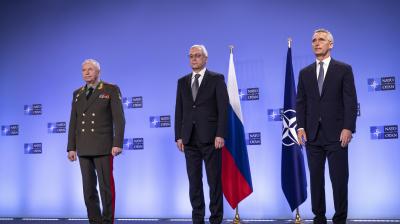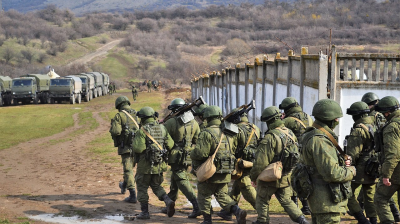Mulling over Minsk: what do the agreements (not) say?
The rapidly deteriorating crisis between Russia, Ukraine and the West has redrawn our attention to the Minsk agreements, the documents agreed in 2014 and 2015 to find a solution to the conflict in eastern Ukraine. After a long pause, meetings in the framework of the so-called Normandy format have resumed. Representatives from Ukraine, Russia, France and Germany gathered in Paris on 26 January and in Berlin on 10 February to continue talks on the basis of the Minsk agreements. In the West, these agreements often get a bad press. Recently, the Economist labeled the accords “a deal imposed by Russia at gunpoint in 2015, which in effect gives Ukraine’s pro-Russian regions a veto over foreign policy”.[i] Generally, however, these agreements are more often referred to than studied, so a closer look at the various agreements that make up ‘Minsk’ may be worthwhile.
Normandy Four and the Trilateral Contact Group
In June 2014, after Russia’s annexation of Crimea and while the separatist conflict in eastern Ukraine was ongoing, the concept of a Normandy Format was proposed on the margins of the 70th anniversary of D-Day. This high-level diplomatic platform between France, Germany, Russia and Ukraine, whose leaders first met in the Belarusian capital, was set up to deal with the crisis in the Donbas region (not Crimea). The leaders tasked a Trilateral Contact Group (TCG) comprising Ukraine, Russia and the Organization for Security and Co-operation in Europe (OSCE) with conducting regular consultations.
The first product of this process was a Protocol signed on 5 September 2014 by TCG representatives, as well as by representatives from the self-proclaimed entities in the Donetsk and Luhansk oblasts (without specifying their capacities). The Protocol was aimed at the implementation of a Ukrainian peace plan, submitted by President Poroshenko on 20 June, and ‘initiatives’ by Russian President Putin. Poroshenko’s plan was never officially disclosed but apparently contained proposals about a 10 km buffer zone along the Ukrainian-Russian border and a process of decentralisation by way of amendments to the Ukrainian constitution.[ii] Constitutional adaptation had already been announced before in the Geneva Statement on Ukraine, released by the US, the EU, Ukraine and Russia on 17 April 2014.[iii]
Protocol – Memorandum 2014
The Protocol represents the first cease-fire deal in this conflict. Some of the document’s other ‘understandings’ include the establishment of security zones on both sides of the Ukrainian-Russian state border, to be monitored by an OSCE mission that had deployed to Ukraine in March 2014. The text also mentions administrative devolution through the adoption of a Ukrainian law on temporary local self-government in certain areas of the Donetsk and Lugansk oblasts (the ‘special status law’). In accordance with this law, early local elections were to follow. The Protocol also determines the withdrawal of all ‘illegal’ military formations, equipment, fighters and mercenaries from Ukraine’s territory.[iv]
When the cease-fire didn’t hold, this sketchy agreement was supplemented by a more elaborate implementation Memorandum, co-signed on 19 September 2014 by the same five representatives. This document details the withdrawal of artillery systems from a zone that extends 15 kilometres either side of the ‘contact line’ (the actual frontline that applied on 19 September) with special clauses for long-range weapons. Apart from other military provisions (the ‘illegal’ formations of the Protocol had turned into ‘foreign’ formations) the Memorandum stipulates that the OSCE monitoring mission be deployed to the area where the cease-fire applies.[v]
‘Minsk II’ 2015
Since the Protocol and the additional Memorandum didn’t bring a cease-fire, let alone peace, to eastern Ukraine, further high-level talks followed. When the security situation deteriorated again and the battle for Debaltseve was raging, direct negotiations between Presidents Poroshenko and Putin, moderated by German Chancellor Merkel and French President Hollande, resulted in the adoption of a ‘Package of Measures for the Implementation of the Minsk Agreements’ (PoM) on 12 February 2015, usually but inaccurately called ‘Minsk-II’.
The PoM reiterates the key points of a cease-fire and the withdrawal of heavy weaponry. Upon this withdrawal, discussions on local elections need to start and the ‘special status law’ must be adopted. Furthermore, the PoM identifies a period from ‘day 1 after local elections’ to a ‘comprehensive political settlement before the end of 2015’ during which full control by Ukraine of its state border will be reinstated. Implementation of this provision does require a constitutional decentralisation process and the agreement by representatives from ‘certain areas in the Donetsk and Lugansk regions’ with the specificities pertaining to their areas, as well as the permanent character of the temporary law on local self-government.[vi]
The pages of the PoM were again initialed by the same five representatives and, importantly, the Package was unanimously endorsed by the UN Security Council in resolution 2202.[vii] Still, no significant progress towards a settlement was achieved, neither at the Normandy Four level nor in the separate working groups under the TCG. As noted before, the talks on these agreements have now been resuscitated, not least because of French President Macron’s diplomatic endeavours.[viii]
Minsk’s imperfections
Peace plans are seldom fair and square documents, for in order to stand a chance of success they have to reflect the balance of forces on the ground. The Minsk agreements were indeed signed under duress, when Ukraine could not match Russia’s military capabilities and feared further incursions into its eastern regions. But, as the current crisis shows, that equation hasn’t changed dramatically. The basic idea initially floated by Kyiv, security guarantees in exchange for constitutional amendments with regard to regions where a separatist insurgency had been staged, still seems relevant.
Of course, a major discrepancy written into the Minsk agreements is that Russia poses as a mediator to assist in finding a resolution to a dispute in which it is heavily involved. No mention is made of ‘Russian Federation’, ‘Russian troops’ or ‘Russia-backed insurgents’, otherwise Russia would never have agreed to the texts. Still, this conspicuous ploy didn’t stop the Security Council from endorsing the PoM. It does however raise a problem for Western states who have made Russia’s ‘full implementation of the Minsk agreements’ a key benchmark for improving ties or, in the EU’s case, for lifting sanctions. This conditionality will have to be measured against the spirit of Minsk, rather than against its disguising letter.
Both Kyiv and Moscow have accused one another of not fulfilling Minsk, prompting both sides to shirk, in Russia’s case at best indirect, duties under the agreements. This is hardly surprising, because Ukraine focuses primarily on the security-related provisions, whereas Russia is more interested in the political outcomes. In terms of ‘sequencing’ these elements play leapfrog in the documents, which leaves ample room for different interpretations. As a bottom line, though, Minsk states the dialogue on the modalities of local elections comes after a cease-fire and the withdrawal of heavy weaponry; obligations that have still not been fully and verifiably implemented.
Engaging the insurgents (and their patrons)
This dialogue itself also continues to be a serious bone of contention. The Protocol refers in general terms to an ‘inclusive all-national dialogue’ while the PoM stipulates that the decentralisation paragraphs of constitutional reforms need to be agreed by representatives of ‘certain areas’ in the east. Such representatives have been involved in signing the Minsk agreements, as well as in the ensuing work of the TCG sub-bodies on security, political, humanitarian and economic issues. Yet Ukrainian President Zelensky has said direct talks with separatist ‘terrorists’ would cross a red line[ix], a position that makes sense against the backdrop of domestic politics but is at variance with the role Minsk assigns to agents from the break-away regions.
Ukraine rightfully stresses that security conditions must allow for further political steps, a correlation that features in the Law On the Special Procedure for Local Self-Government in Certain Districts of Donetsk and Luhansk Regions that Ukraine’s parliament initially adopted in September 2014, and that has recently been prolonged until the end of 2022.[x] Obviously, Russia has a major role to play in this regard. The prematurely organised ‘parliamentary’ and ‘presidential’ elections in the self-proclaimed republics in November 2014, whose results were ‘acknowledged’ by Russian officials, were clearly an act of bad faith contravening the agreements.
Still, when Ukraine says it will continue talks on the basis of Minsk[xi], and if reintegration of the conflict areas is still on the agenda, it is difficult to see how interaction with the local powers that be, Russian puppets or not, can be avoided. In many other peace processes governments negotiate with separatists. Take, for instance, the so-called 5+2 format that includes Moldova and its break-away region Transnistria. As an interested party, Ukraine is also part of this framework.
Finally, the assertion that Minsk paves the way for Ukraine’s loss of sovereignty in foreign affairs has more to do with apprehensions about Russia’s longer-term goals than with a proper reading of the agreements. Minsk covers the eventual devolution of competences in the field of linguistic, socio-economic and cross-border issues to local bodies, and is silent on foreign and security policy. Indeed, given Russia’s publicly stated designs on Ukraine’s future it is difficult to envision Moscow settling for local police reform while Kyiv regains full control over the disputed territories. But the spectre of hostile takeover needs to be addressed in difficult negotiations, and does not emerge from Minsk’s wordings.
Rather Minsk than other contingencies
The subject matter of the Minsk agreements is only part of a bigger issue, but progressing towards a settlement in eastern Ukraine is a necessary condition for addressing wider antagonisms. For sure, the agreements are lop-sided, imperfect and often ambiguous. Besides, they fall within the remit of a format that excludes America, which remains a key protagonist in this crisis. On the other hand, Normandy represents a European framework that operates in parallel with Russia’s broader tracks with Washington and NATO to address a very European security crisis. And despite having withered on the vine for so many years, and apparently for want of anything better, at the time of this writing Minsk is still formally accepted by all relevant parties, Ukraine’s and Russia’s recriminations notwithstanding. Its provisions may be deficient but, as a minimal basis for further talks, probably offer better prospects than coercive military diplomacy or the unilateral recognition of self-proclaimed fiefdoms in Ukraine’s conflict zone.



